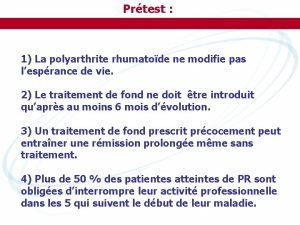TNF in the Development of the Hippocampus and

- Slides: 1

TNF in the Development of the Hippocampus and Hippocampal Dependent Cognitive Tasks Camara M 1, Anscomb H. L. 2 and Baune B. T. 1, 2 PSYCHIATRIC NEUROSCIENCE, JAMES COOK UNIVERSITY, TOWNSVILLE, QUEENSLAND 2 DISCIPLINE OF ANATOMY, JAMES COOK UNIVERSITY, TOWNSVILLE, QUEENSLAND 3 DISCIPLINE OF PSYCHIATRY, UNIVERSITY OF ADELAIDE, SOUTH AUSTRALIA s 1 BACKGROUND Tumor necrosis factor (TNF) is an effector cytokine involved in numerous pathologies and inflammatory responses [1]. The source of TNF in the CNS is mainly astrocytes and microglia [2 -5]. In addition to its inflammatory function TNF is required for hippocampal development [6] and development of hippocampal dependent cognitive tasks (memory and learning). RESULTS IHC staining revealed in GFAP-TNF+/+ mice an accumulation of TNF in hippocampal neurons prior to the onset of hippocampal-dependent behavioural deficits. GFAP-TNF+/+ mice also showed a significant increase in TNF in regions CA 3 and the DG (p = <0. 05) when compared to WT and TNF-/- mice of the same age. TNF in the Hippocampus 40 TNF-IR Cell 20 Count 0 C 57/BL 6 Figure 1: Role of TNF in Neurotrophin Production and Hippocampal Memory and Learning. Work by this group has demonstrated that deficiency of TNF (TNF-/- mice) resulted in cognitive dysfunction of spatial memory and learning, measured by the Barnes maze, during early stages of development (3 month old mice) [7]. Figure 2 : Study by Baune et al [7] Showing how Spatial Learning in 3 Month Old Mice Is Impaired by the Deficiency of TNF. METHODS This study uses Imunnohistochemistry (IHC) to investigate cellular changes present in the hippocampal formation as a result of up-regulation of astrocyte-produced tumor necrosis factor (TNF) (GFAP-TNF+/+), prior to and following the onset of behavioural deficits. These findings are compared to the hippocampal formation of a TNF knock-out model (TNF -/-) and wild type (C 57 BL/6) control mice Cytokine analysis was also performed on hippocampal formation tissue of GFAP-TNF+/+ and wild type (WT) mice to test for TNF expression using a cytometric bead array (CBA) mouse inflammation Kit. Cytokine analysis was not performed in TNF-/- mice as they do not express TNF. Hippocampal tissue was analysed at 3 and 12 months of age to examine the change in TNF expression with increasing age. REFERENCES 1. Vassalli, P. , The pathophysiology of tumor necrosis factors. Annu Rev Immunol, 1992. 10: p. 411 -52. 2. Sawada, M. , et al. , Production of tumor necrosis factor-alpha by microglia and astrocytes in culture. Brain Res, 1989. 491(2): p. 394 -7. 3. Chung, I. Y. and E. N. Benveniste, Tumor necrosis factor-alpha production by astrocytes. Induction by lipopolysaccharide, IFN-gamma, and IL-1 beta. J Immunol, 1990. 144(8): p. 2999 -3007. 4. Silva, A. R. , et al. , The flavonoid rutin induces astrocyte and microglia activation and regulates TNF-alpha and NO release in primary glial cell cultures. Cell Biol Toxicol, 2008. 24(1): p. 75 -86. 5. Lieberman, A. P. , et al. , Production of tumor necrosis factor and other cytokines by astrocytes stimulated with lipopolysaccharide or a neurotropic virus. Proc Natl Acad Sci U S A, 1989. 86(16): p. 6348 -52. 6. Golan, H. , et al. , Involvement of tumor necrosis factor alpha in hippocampal development and function. Cereb Cortex, 2004. 14(1): p. 97 -105. 7. Baune, B. T. , et al. , Cognitive dysfunction in mice deficient for TNF- and its receptors. Am J Med Genet B Neuropsychiatr Genet, 2008. 147 B(7): p. 1056 -64. 8. World Alzheimer report 2010 TNF-/- CA 1 CA 3 Figure 3 : Graph Showing Difference in Concentration of TNF in C 57/Bl 6, TNF-/and TNF-GFAP+/+ Mice in CA 1, CA 3 and DG Regions (IHC Analysis). GFAP-CA 3 GFAP Figure 4 : IHC Analysis Showing Expression of TNF In Hippocampus of TNF-/Mice. Figure 5 : IHC Analysis Showing Concentration of TNF in the CA 3 Region GFAP -TNF+/+ Mice. CBA analysis showed an up-regulation of TNF in the hippocampus from 3 months to 12 months in both strains of mice (WT mice p=0. 0153, GFAP+/+ mice, p= 0. 0017), showing a significant increase in inflammation occurs in the aged brain in normal (WT mice) as well as pathological (TNF-GFAP+/+ mice). GFAP+/+ mice also had a significantly higher expression of TNFα in the hippocampal formation compared to WT mice (p=0. 0001) and TNF-/- mice did not express TNF. Figure 6 : Graph Illustrating the Concentration of TNF in 3 Month and 12 Month old Hippocampal Tissue of C 57/BL 6 and GFAP-TNF+/+ Mice, Analyzed by CBA. CONCLUSION These findings suggest that TNF is essential for normal development and functioning of the hippocampus in cognitive processes. In addition, an overproduction of TNF accumulates specifically in the neurons of the CA 3 and DG regions and likely produces functional deficits, as seen in 6 months plus mice, through these regions. SIGNIFICANCE Cognitive dysfunction is an essential symptom of depression, dementia and Alzheimer’s Disease (AD). Understanding of cognitive function in the early stages of dementia will allow development of effective strategies to enhance the treatment of cognitive deficits and for the prevention of chronic diseases that reduce productive ageing, quality of life and functional independence. Growing evidence suggests that during health TNF plays an important role in synaptic plasticity and several other processes sub-serving cognition, such as the modulation of neurotransmitters and both neuronal and glial cell function and further work in this area will help to clarify the details of these cellular mechanisms leading to cognitive decline. ACKNOWLEDGEMENTS I would like to thank my supervisors, Prof. Bernhard Baune and Dr. Helen Anscomb for the opportunity to conduct this research. marie. camara@my. jcu. edu. au Figure 7 : Prevalence of Dementia for People Aged 60 yrs and Over (2010)[8]. Figure 8 : Growth In Numbers of People With Dementia in High, Low and Middle Income Countries [8].

